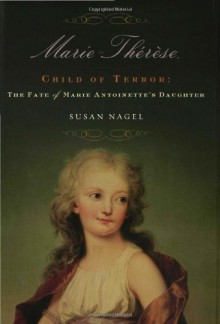 Marie-Thérèse is not always the first name remembered in the history of the French Revolution, surrounded as she was by more famous, more tragic, more ambitious people. She was Madame Royale, the Duchess d'Angoulême, the Dauphine and (to legitimists) the Queen of France. In her own time, she was more famous as the Orphan of the Temple. Marie-Thérèse was eleven when the French Revolution began. Her one surviving sibling, Louis Charles, was four. The family was forced from their home at Versailles to the Tuileries Palace in Paris, then on August 13th, 1792 they were imprisoned in the tower of the Temple Palace. Marie-Thérèse would not leave it until September 19th, 1795, her seventeenth birthday. Over a year of her time in the Temple was in solitary confinement. The tragedy is, she was likely the luckiest of her family. Her mother, father and aunt were guillotined. Her brother Louis-Charles was tortured, brainwashed and eventually left neglected. His health deteriorated to the point that the well meaning doctor who discovered his fate was unable to break through the bureaucrcy in time to help him. Since his burial place was never establish, Marie-Thérèse was plagued with doubts as to his final fate -- and plagued as well by dozens of men claiming to be her brother. Despite the horrid events that surrounded some of the most formative years of her life, Marie-Thérèse went on to be a strong, noble and loving woman, as loyal to the country that betrayed her as she was to the uncles that were her only remaining family. She did have her faults. She was an extreme ultra-royalist, and though she had learned her father's lesson and often toured her country to be in touch with the people, she believed completely in the divinity of Bourbon blood. One does wonder if she had given her nephew, the Duc de Bordeaux, a less reactionary education, he might have accepted ruling alongside the tricolour rather than remain in exile. Her unwitting legacy to her country was the Third Republic. Nagel has an interesting relationship with her subject. While she glosses over the few people who did not like Marie-Thérèse (who does occasionally seem eye-rollingly saint-like), in her afterword Nagel shows an almost bloodthirsty desire to exhume her body to solve the mystery the Dark Countess -- who popular legend painted as the real Marie-Thérèse-Charlotte de France, switched with a double immediately after her release from the Temple. It's only when she is denied that route that Nagel turns to handwriting comparisons for a solution. On the surface, it's almost as chilling as the doctor that kept futilely trying to contact Marie-Thérèse, claiming he had taken her brother's heart from his body and wanted to return it to her...
Marie-Thérèse is not always the first name remembered in the history of the French Revolution, surrounded as she was by more famous, more tragic, more ambitious people. She was Madame Royale, the Duchess d'Angoulême, the Dauphine and (to legitimists) the Queen of France. In her own time, she was more famous as the Orphan of the Temple. Marie-Thérèse was eleven when the French Revolution began. Her one surviving sibling, Louis Charles, was four. The family was forced from their home at Versailles to the Tuileries Palace in Paris, then on August 13th, 1792 they were imprisoned in the tower of the Temple Palace. Marie-Thérèse would not leave it until September 19th, 1795, her seventeenth birthday. Over a year of her time in the Temple was in solitary confinement. The tragedy is, she was likely the luckiest of her family. Her mother, father and aunt were guillotined. Her brother Louis-Charles was tortured, brainwashed and eventually left neglected. His health deteriorated to the point that the well meaning doctor who discovered his fate was unable to break through the bureaucrcy in time to help him. Since his burial place was never establish, Marie-Thérèse was plagued with doubts as to his final fate -- and plagued as well by dozens of men claiming to be her brother. Despite the horrid events that surrounded some of the most formative years of her life, Marie-Thérèse went on to be a strong, noble and loving woman, as loyal to the country that betrayed her as she was to the uncles that were her only remaining family. She did have her faults. She was an extreme ultra-royalist, and though she had learned her father's lesson and often toured her country to be in touch with the people, she believed completely in the divinity of Bourbon blood. One does wonder if she had given her nephew, the Duc de Bordeaux, a less reactionary education, he might have accepted ruling alongside the tricolour rather than remain in exile. Her unwitting legacy to her country was the Third Republic. Nagel has an interesting relationship with her subject. While she glosses over the few people who did not like Marie-Thérèse (who does occasionally seem eye-rollingly saint-like), in her afterword Nagel shows an almost bloodthirsty desire to exhume her body to solve the mystery the Dark Countess -- who popular legend painted as the real Marie-Thérèse-Charlotte de France, switched with a double immediately after her release from the Temple. It's only when she is denied that route that Nagel turns to handwriting comparisons for a solution. On the surface, it's almost as chilling as the doctor that kept futilely trying to contact Marie-Thérèse, claiming he had taken her brother's heart from his body and wanted to return it to her...

 Log in with Facebook
Log in with Facebook 





